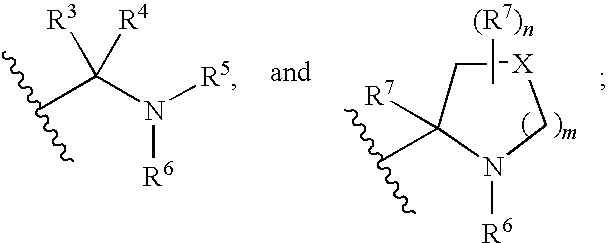Hepatitis c virus inhibitors
a technology of hepatitis c virus and inhibitors, which is applied in the direction of drug compositions, antibody medical ingredients, peptide/protein ingredients, etc., can solve the problems of hcv genotype, inability to develop a successful vaccine in the near future, and inability to effectively treat infections, etc., to achieve treatment or prophylaxis of viral infections
- Summary
- Abstract
- Description
- Claims
- Application Information
AI Technical Summary
Problems solved by technology
Method used
Image
Examples
example 1
[0187]
Step 1a. A mixture of N-Boc-L-proline (2.289 g, 10.6 mmol) and 5-bromo-2,3-diaminobenzene (2.00 g, 10.6 mmol) in DMF (40 mL) were treated with EDC−HCl (2.651 g, 13.8 mmol) and DMAP (0.130 g, 1.06 mmol) at rt for 12 hours and then at 60° C. for another 12 hours. The resultant dark mixture was partitioned (EtOAc—water). The combined organics were washed with brine, dried over Na2SO4, filtered and evaporated to give the crude desired compound as a dark brown foam which was directed used in the next step. ESIMS m / z=385.23, 387.23 [M+H]+.
Step 1b. A solution of the crude compound from step 1a (theo. 10.6 mmol) in glacial acetic acid (100 mL) was heated at 50° C. for 24 hours. The volatiles were evaporated and the resultant dark mixture was partitioned between EtOAc and saturated aqueous NaHCO3. The organics were washed with brine, dried over Na2SO4, filtered and evaporated. The residue was purified by flash column chromatography (silica, hexanes-ethyl acetate) to give the desired co...
example 2
[0188]
[0189]A solution of the compound from example 1 (8 mg, 0.012 mmol) in CH2Cl2 (1 mL) was treated with hydrogen chloride (4M in dioxane, 5 mL) at rt for 40 minutes before all volatiles were removed by rotavap. The residue was redissolved in DMF (2 mL) and was added DIPEA (0.3 mL, 2.1 mmol), HATU (20 mg, 0.053 mmol) and (R)-(methoxycarbonyl)-aminophenyl acetic acid (prepared according to WO 2008 / 021927, 16 mg, 0.053 mmol). The resulting mixture was stirred at rt for 40 minutes before all volatiles was removed by N2 flow. The residue was chromatographed (silica, CH2Cl2-MeOH) to give the title compound (1.2 mg). ESIMS m / z=833.38 [M+H]+.
[0190]The remaining compounds of examples 3-508 may be prepared using procedures similar to that described in examples 1, 2, and 509-516, and / or as described in the Synthetic Methods.
TABLE 1aExample 3-219.Entry3456789101112131415161718192021222324252627282930313233343536373839404142434445464748495051525354555657585960616263646566676869707172737475767...
example 509
[0191]
Step 509a. A mixture of N-Boc-L-proline (0.229 g, 1.06 mmol) and TEA (0.15 mL, 1.06 mmol) in THF (10 mL) at −20° C. was treated with iso-butyl chloroformate (0.14 mL, 1.06 mmol) for 30 minutes before a slow addition of 6-bromopyridine-2,3-diamine (prepared according to WO 2004 / 002986 and WO 2008 / 021851, 0.200 g, 1.06 mmol) in THF (2 mL). It was then kept at −20° C. for 1 hour and then slowly warmed up to rt and stirred at rt overnight. The volatiles were evaporated and the residue was partitioned (EtOAc—water). The organics were washed with brine, dried (Na2SO4), filtered and evaporated to give the crude desired compound as a very light brown solid (0.430 g). ESIMS m / z=385.17, 387.17 [M+H]+.
Step 509b. A solution of the crude compound from step 509a (1.06 mmol at most) in glacial acetic acid (12 mL) was heated at 80° C. for 3 days. The volatiles were evaporated off and the residue was partitioned (EtOAc—saturated aqueous NaHCO3). The organics were washed with brine, dried (Na2S...
PUM
| Property | Measurement | Unit |
|---|---|---|
| body weight | aaaaa | aaaaa |
| body weight | aaaaa | aaaaa |
| width | aaaaa | aaaaa |
Abstract
Description
Claims
Application Information
 Login to View More
Login to View More - R&D
- Intellectual Property
- Life Sciences
- Materials
- Tech Scout
- Unparalleled Data Quality
- Higher Quality Content
- 60% Fewer Hallucinations
Browse by: Latest US Patents, China's latest patents, Technical Efficacy Thesaurus, Application Domain, Technology Topic, Popular Technical Reports.
© 2025 PatSnap. All rights reserved.Legal|Privacy policy|Modern Slavery Act Transparency Statement|Sitemap|About US| Contact US: help@patsnap.com



